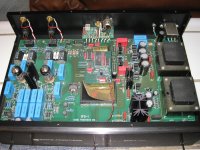Have your friend figure out if the label's paper, or something else, and also if it gets hot in use there.
It's paper on the bottom and foil on top.
It gets pretty hot in there (too hot to touch), requires ventilation.
It gets pretty hot in there (too hot to touch), requires ventilation.
Sounds like the label is a bi-metal strip designed to bend under temperature change!
I see some things in there that get hot, but is the little box another heat source?
Either way, if it were mine I think I'd pull the labels off and keep them in a drawer.
I see some things in there that get hot, but is the little box another heat source?
Either way, if it were mine I think I'd pull the labels off and keep them in a drawer.
Not a bad idea. They're basically just floating there now. When the DAC has been on for an hour they pretty much flatten all the way down. Maybe I'll tuck them away somewhere.
Save them for when you sell it.
Can you imagine if one curled up and shorted something underneath the pcb?!
Can you imagine if one curled up and shorted something underneath the pcb?!
I'd stick them back down with some contact cement. DAP's (for instance) is good for 180ºF once it's cured for 72 hours.
Ah cool. This stuff is safe to use on plastic long term?I'd stick them back down with some contact cement. DAP's (for instance) is good for 180ºF once it's cured for 72 hours.
The tape that we use industrially for electronics is Kapton. For example Botron Low-Static Kapton Tape, 1/2" from Botron Mektronics Australia
It's essentially heavy duty sticky tape. The first time I used it was for protecting gold plated edge connectors when feeding circuit boards through wave soldering machines, back when wave soldering was still a thing. It's also used for holding assemblies together before they go through reflow ovens, holding the guts of transformers together, pretty much everywhere in electronics assembly. You can literally apply the hot end of a soldering iron to it without damaging it.
It's essentially heavy duty sticky tape. The first time I used it was for protecting gold plated edge connectors when feeding circuit boards through wave soldering machines, back when wave soldering was still a thing. It's also used for holding assemblies together before they go through reflow ovens, holding the guts of transformers together, pretty much everywhere in electronics assembly. You can literally apply the hot end of a soldering iron to it without damaging it.
Last edited:
Yes, contact cement is safe on plastics. (Those components appear to have been potted in epoxy, which would make any safety concerns fairly moot as there's very little that will attack cured epoxy.)
The main benefit of polyimide tapes (such as Kapton) is the substrate of the tape (the plasticy bit rather than the sticky bit). That being said, polyimide tapes generally use a pressure-sensitive silicone adhesive, so that would be a good choice for glueing the labels back down too. Any non-corrosive silicone adhesive would work (and would have the advantage of less residue if you ever needed to remove it again).
The main benefit of polyimide tapes (such as Kapton) is the substrate of the tape (the plasticy bit rather than the sticky bit). That being said, polyimide tapes generally use a pressure-sensitive silicone adhesive, so that would be a good choice for glueing the labels back down too. Any non-corrosive silicone adhesive would work (and would have the advantage of less residue if you ever needed to remove it again).
- Status
- Not open for further replies.
- Home
- Design & Build
- Construction Tips
- Electronics and Heat Safe Adhesive/Tape/Sticky Substance?
